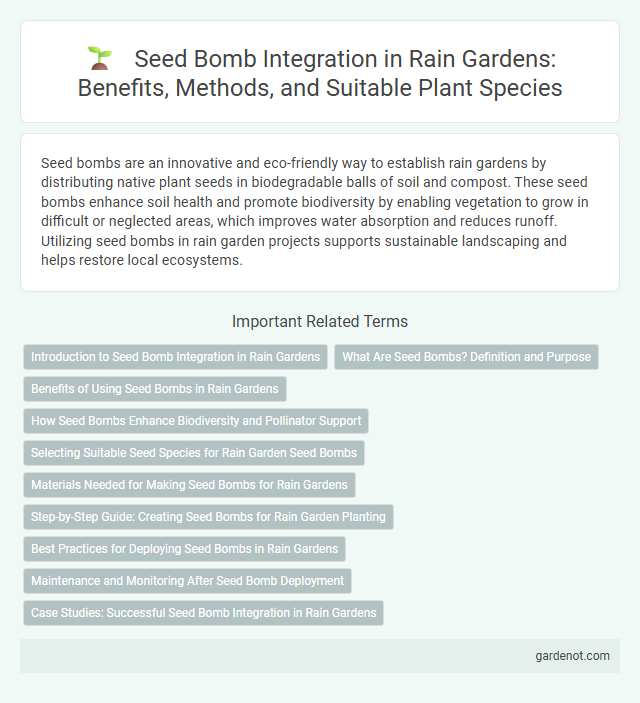Seed bombs are an innovative and eco-friendly way to establish rain gardens by distributing native plant seeds in biodegradable balls of soil and compost. These seed bombs enhance soil health and promote biodiversity by enabling vegetation to grow in difficult or neglected areas, which improves water absorption and reduces runoff. Utilizing seed bombs in rain garden projects supports sustainable landscaping and helps restore local ecosystems.
Introduction to Seed Bomb Integration in Rain Gardens
Seed bombs, compact clusters of native wildflower seeds encased in a nutrient-rich clay and compost mix, enhance rain gardens by promoting biodiversity and improving soil health. Integrating seed bombs into rain gardens facilitates the natural establishment of drought-tolerant plants that absorb stormwater runoff and reduce erosion. This technique supports sustainable urban landscaping by increasing vegetation coverage and fostering habitat creation for pollinators and other beneficial wildlife.
What Are Seed Bombs? Definition and Purpose
Seed bombs are compact clusters of seeds encased in a mixture of clay, compost, and soil designed to facilitate easy planting and promote vegetation growth. Their primary purpose is to restore ecosystems, enhance biodiversity, and support rain gardens by introducing native plants in hard-to-reach or degraded areas. This low-maintenance technique aids in soil improvement, erosion control, and water absorption, benefiting urban and natural landscapes.
Benefits of Using Seed Bombs in Rain Gardens
Seed bombs in rain gardens enhance biodiversity by introducing native wildflowers and grasses that improve habitat quality for pollinators and wildlife. They promote soil stabilization and water absorption, reducing erosion and runoff while increasing groundwater recharge. Using seed bombs simplifies planting and ensures even distribution of seeds, fostering a resilient and low-maintenance rain garden ecosystem.
How Seed Bombs Enhance Biodiversity and Pollinator Support
Seed bombs boost biodiversity by dispersing native wildflower seeds that attract diverse pollinators such as bees, butterflies, and hummingbirds. These compact seed clusters improve soil health and increase plant variety in rain gardens, creating vibrant habitats essential for ecological balance. By promoting robust pollinator populations, seed bombs support ecosystem services critical for plant reproduction and food webs.
Selecting Suitable Seed Species for Rain Garden Seed Bombs
Selecting suitable seed species for rain garden seed bombs involves choosing native plants adapted to local climate and soil conditions, ensuring robust growth and ecological benefits. Prioritize species with deep root systems like wildflowers, grasses, and sedges that enhance water infiltration and prevent erosion. Incorporating diverse, drought-tolerant varieties supports pollinators and maximizes rain garden resilience.
Materials Needed for Making Seed Bombs for Rain Gardens
Seed bombs for rain gardens require a blend of clay powder, compost, and native wildflower seeds to ensure optimal growth and soil compatibility. Clay holds the seed together and maintains moisture, while compost provides essential nutrients to enhance germination and support plant development. Using locally sourced materials boosts the environmental benefits by promoting biodiversity and reducing the introduction of invasive species.
Step-by-Step Guide: Creating Seed Bombs for Rain Garden Planting
Creating seed bombs for rain garden planting begins by mixing native wildflower seeds with a blend of clay powder and compost to form a cohesive dough. Shape the mixture into small balls roughly one inch in diameter and allow them to dry for 24-48 hours in a shaded area to prevent premature germination. Once dry, distribute seed bombs evenly across the rain garden area to promote natural, sustainable vegetation growth that supports stormwater management.
Best Practices for Deploying Seed Bombs in Rain Gardens
Seed bombs are an effective method for establishing native plants in rain gardens, requiring proper soil preparation by loosening the top layer to ensure seed-to-soil contact. Optimal timing for deployment is during the early rainy season to support germination and reduce watering needs. Using a mix of native wildflower and grass seeds tailored to local climate and soil conditions enhances biodiversity and long-term rain garden sustainability.
Maintenance and Monitoring After Seed Bomb Deployment
Regular watering and soil moisture monitoring are crucial for seed bomb germination and plant establishment in rain gardens. Inspect the site weekly to identify signs of pest damage, erosion, or poor seedling growth, ensuring timely interventions like mulching or supplemental watering. Tracking plant emergence and health supports adaptive maintenance strategies that enhance rain garden performance and biodiversity.
Case Studies: Successful Seed Bomb Integration in Rain Gardens
Case studies highlight that seed bombs containing native wildflower seeds significantly enhance biodiversity when integrated into rain gardens, promoting pollinator habitats and improving soil health. In urban settings, projects in Seattle demonstrated a 40% increase in native plant coverage and a 25% rise in local bee populations within six months of seed bomb application. These successful implementations underscore seed bombs as an effective tool for sustainable rain garden vegetation establishment and ecosystem resilience.
Seed bomb Infographic

 gardenot.com
gardenot.com